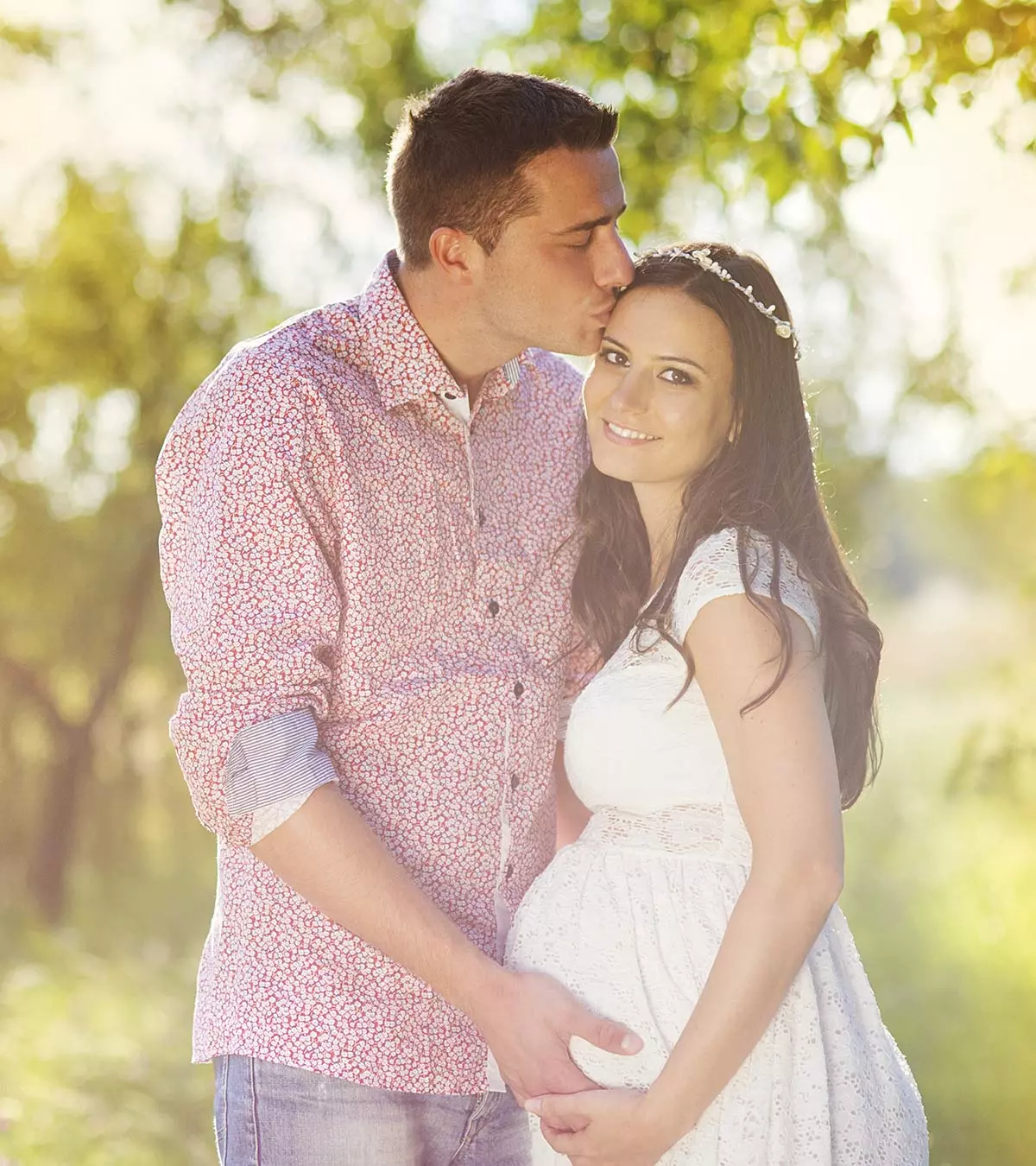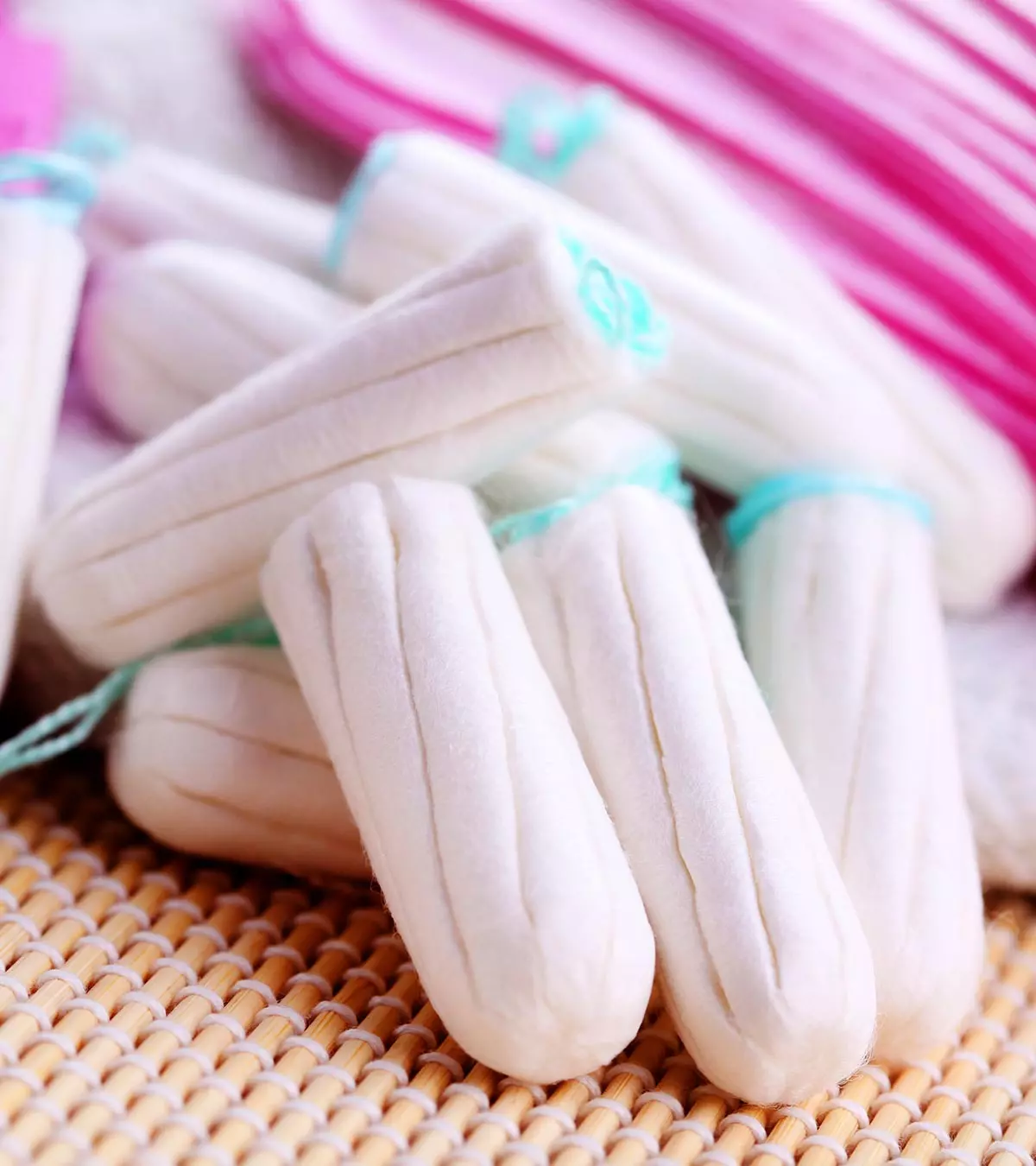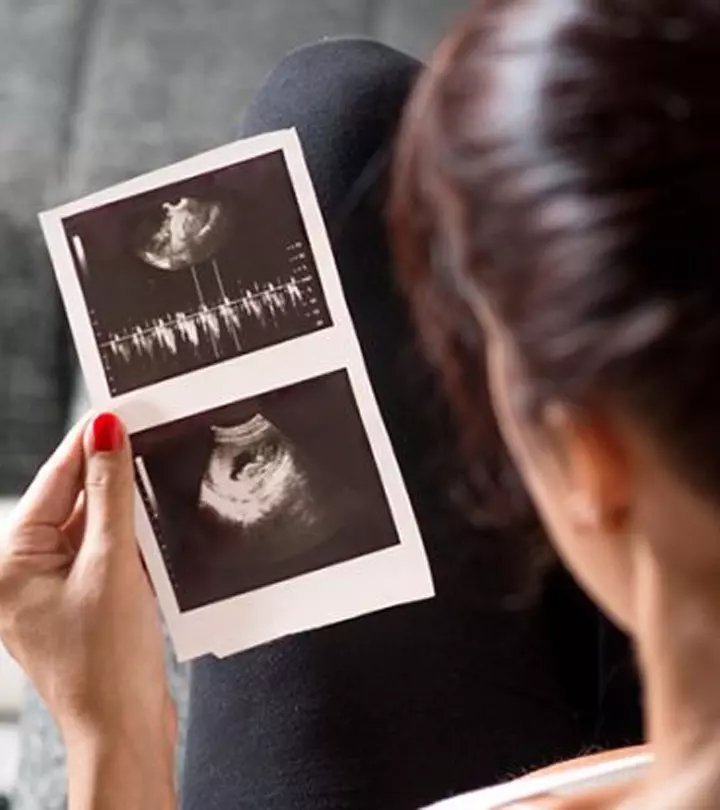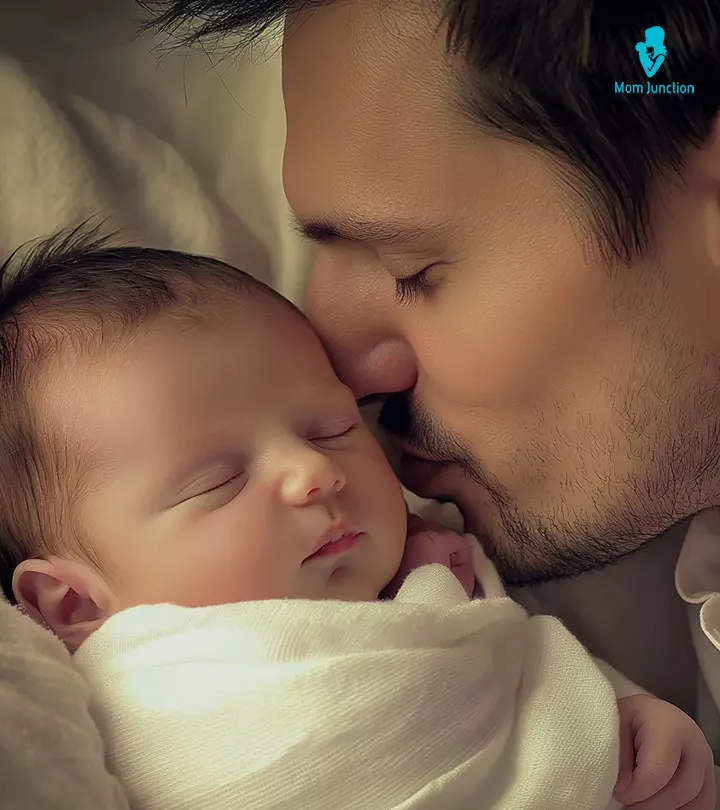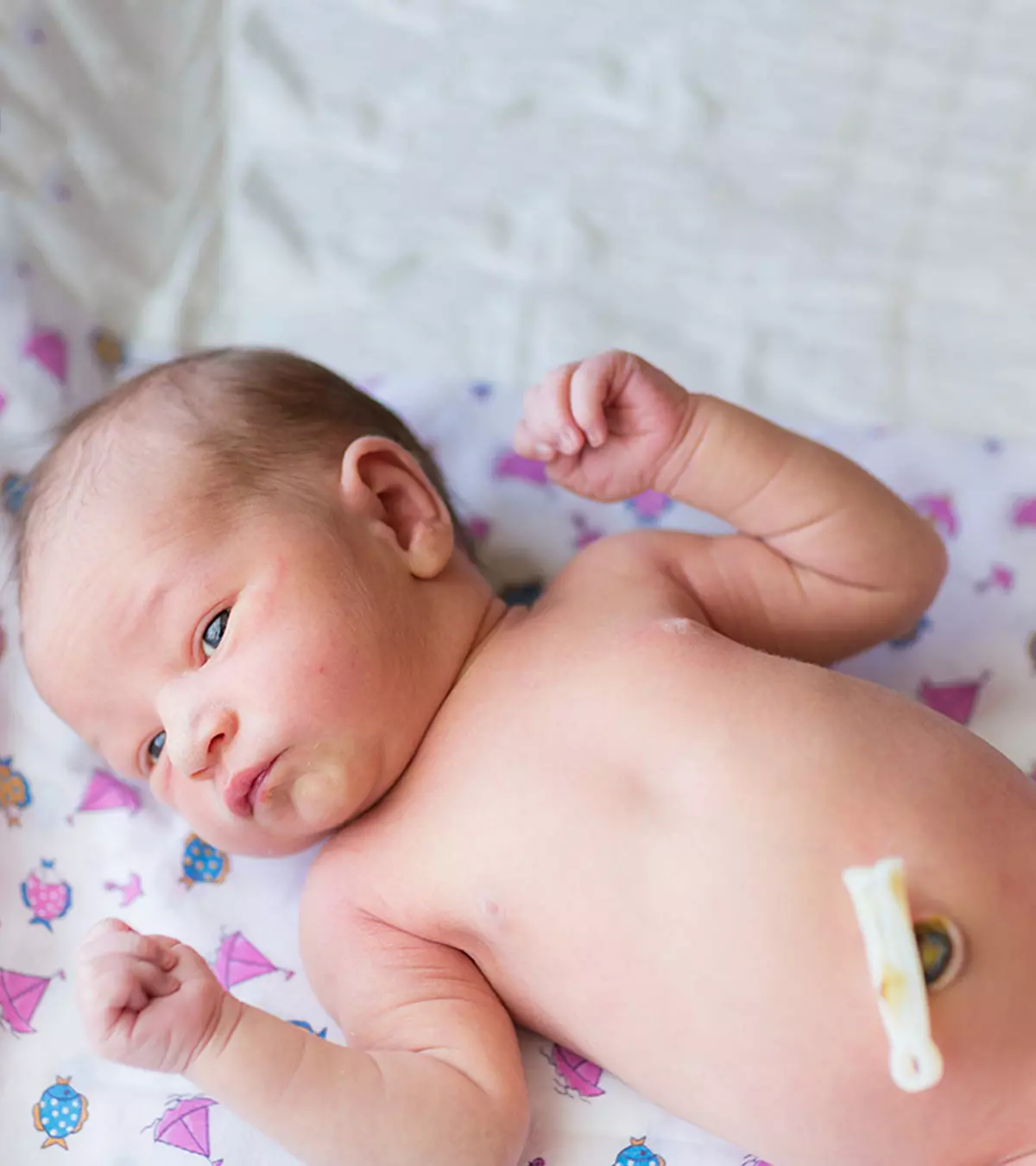
Image: ShutterStock
A belly button or a navel is a depression in the person’s belly. It is formed when the umbilical cord of the newborn is cut and clamped soon after delivery, dries, and falls within a few days. Babies can have an innie or outie belly button, also known as the umbilicus. While the majority of newborns have an innie umbilicus, a few may have an outie. Keep reading this post to learn how an outie develops, if it’s normal to have an outie navel, and tips to take care of your belly button.

Key Pointers
- An outie belly button in newborns is normal and occurs when the belly button bulges out.
- An outie belly button may sometimes be due to a medical condition such as umbilical hernia.
- When the abdominal muscles become stronger, the outie can go in, but an outie usually does not become an innie.
- If a baby has abdominal pain or swelling around the belly button, vomiting, or fever, medical attention is warranted.
What Is An Outie Belly Button?
An outie belly button is the one that protrudes. Usually, the belly button moves inside and is called an innie.
An outie looks like a tiny balloon. It blows out when the baby is crying, laughing, coughing, or has bowel movements. This is because of the increased pressure from inside the abdomen. It shrinks when the baby is relaxing.
Why Does Your Newborn Have An Outie Belly Button?
Outies are usually caused due to two reasons:
- A common reason for an outie belly button is an umbilical hernia in babies (1).
- A granulation tissueiA layer of tissue that forms over wounds and facilitates the healing process. is formed at the umbilicus resulting in excess loose skin at the region.
 Quick fact
Quick factOutie Due To Umbilical Hernia
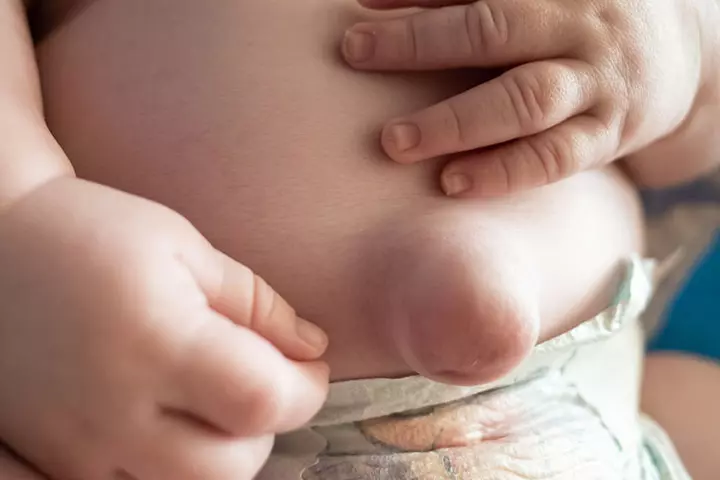
The umbilical hernia is formed due to weak spots in the muscle wall around the abdomen of the baby.
Inside the mother’s womb, the umbilical cord connects through the baby’s abdomen. Once the baby comes out and the cord is cut, an opening is formed at the place, which gets sealed with the help of the muscles.
In some cases, the muscles don’t seal it completely, creating a small hole. Hernia occurs when a part of the intestine bulges out through the weak spot in the muscles.
According to the American College of Surgeons, certain factors, such as preterm birth, low birth weight in babies, and African-American or Hispanic ethnicity, may increase the risk of umbilical hernias in newborns (2).
 Research says
Research saysSymptoms Of Serious Umbilical Hernia
Hernia is usually harmless, and your baby will not have any pain.
However, in rare cases, the intestine gets stuck in the hole, which may lead to infection. If you notice these symptoms, take your baby to a doctor immediately (3):
- Pain around the belly button
- Change in the color around the hernia
- Swelling in the region
- Vomiting
- Fever
During a routine checkup, Dr. Tahir from Family Pediatrics examined baby Maran and noticed a belly button hernia. He says, “Baby Maran is here today, and she is one month old. During her checkup, we noticed a swelling in her belly button, which her mom brought to my attention. It’s not too uncommon for babies to have a belly button hernia. This is basically when the intestines are pushing up from inside the tummy and bulging out through the belly button.
“When I squish it in, I can feel that there’s an opening about the size of my little finger in the wall of the abdomen. This will eventually close over time, usually by about one year of age. If it ever causes a problem or doesn’t go away after a couple of years, we may need to consult a surgeon who can close the hole with a couple of sutures (i).”
When Does A Baby’s Belly Button Go In?
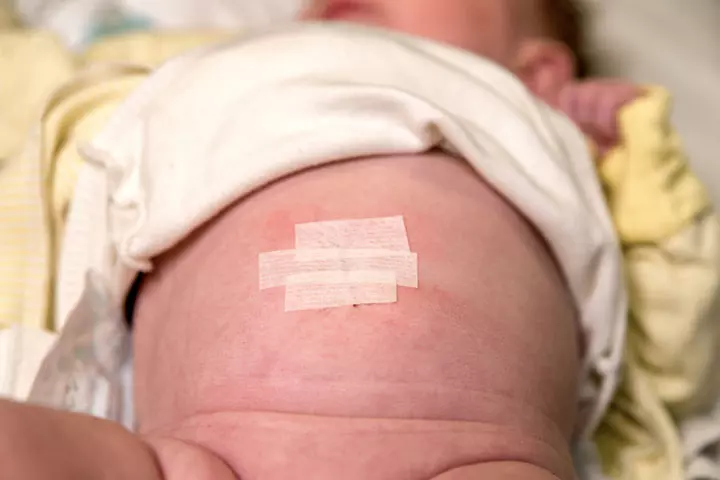
An outie cannot become an innie but it does go in once the muscles in the abdomen grow stronger and the hole gets healed by itself. The hole usually closes within 12 to 18 months but takes longer if it is bigger. The physician can assess how small or big the hole is and assess if the hernia will resolve and close within a few months. Small umbilical hernias close by one year of age.
Researchers from the Johns Hopkins University state that in 90% of cases, umbilical hernias close by the time a child reaches five (3). However, in rare cases, a child may need to undergo a hernia repair surgery under the age of three. A cohort study (2018) by the Boston Children’s Hospital and Harvard Medical School researchers indicated that 29.6% (7,650) of 25,877 children who underwent umbilical hernia repairs were below three years (4).
Surgery For Umbilical Hernia
Surgery is required if (3):
- the hole does not close by the age of three.
- the intestine is stuck in the opening and intestinal obstruction may occur.
- the hernia grows bigger as the child grows.
The surgery is a simple procedure that takes around 20 to 30 minutes. The doctor will make a small incision at the umbilicus and push the protruded part/tissue inside. They will then stitch together the opening in the abdomen wall. The procedure is done under general anesthesiaiA medication used to induce sleep during a surgical process. (1).
Laura, a mother of four, was faced with the option of surgery when her daughter Millie had a case where her belly button didn’t close properly. She says, “Millie (her daughter) had a small intestine and a large intestine out (outside of her body), so they just kind of popped it all back during the surgery and then closed the belly button up, which went well (ii).”
 Trivia
TriviaHow To Take Care Of Your Newborn’s Belly Button Area?
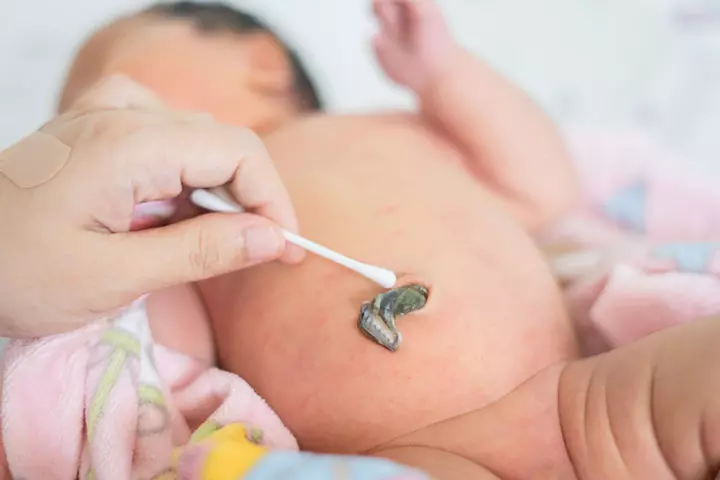
Your baby’s belly button needs to be dry and free of any infection. Here is how you can take care of the area (6):
- Keep the base dry because a dryer cord falls sooner than a wet one.
- Clean the base of the cord with a cotton swab every time you change your baby’s nappy.
- Do not cover the area with the nappy. Fold the nappy down.
- Covering up the cord with the nappy could result in infection due to lack of air circulation and the baby’s urine.
- Earlier, pediatricians used to suggest cleaning of the region with alcohol, but the practice is not being encouraged now.
- Never try to remove the cord forcefully. Let it fall off naturally.
- Use a mild soap to clean the area. Ask your doctor to recommend a suitable soap.
- Give a sponge bath to your baby in the initial days to avoid wetting the cord.
- Take your baby for regular check-ups, and contact the doctor if you notice any signs of infection.
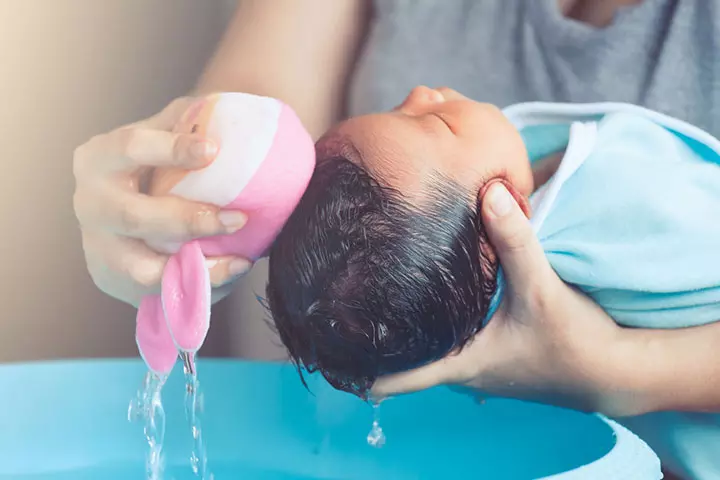
Infection Of Baby’s Belly Button
The belly button of your baby could be infected if (6):
- yellow or white pus oozes from it.
- the base is red or swollen.
- the cord is bleeding.
- there is pain in the navel.
Signs of infection of the umbilical cord stump could result in a life-threatening infection called omphalitis. Omphalitis is a local infection of the umbilicus but can spread in the body. This is a serious condition, which needs to be treated immediately.
When Should You Call The Doctor?
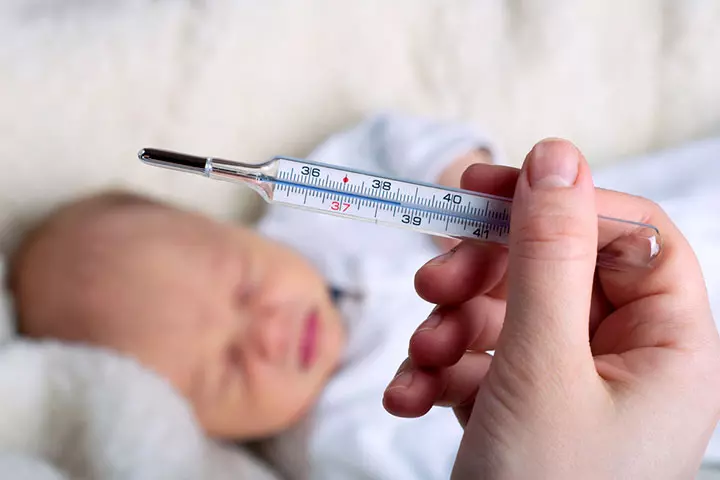
Watch out for these signs of infection and call your pediatrician immediately:
- Foul smell from the area
- Yellow sticky discharge from the area
- Swelling, tenderness or redness in the skin around the area
- High fever
- Persistent crying or unusual irritability
- Weakness or excessive drowsiness
- Not interested in being fed or feeding very little
- Skin appears to look saggy and floppy around the area
Frequently Asked Questions
1. Can I change my baby’s belly button to be outie or innie?
No, you cannot make your baby’s belly button an outie or innie. Not even the obstetrician can do it for you as the formation is natural.
Contrary to popular belief, an outie is not formed due to the faulty cutting or clamping of the cord. It is due to weakness in the abdominal muscle.
2. Does pressing a coin push the belly button inside?
The practice of taping a coin on the belly button is prevalent among various cultures to push it inside. However, it does not help the navel in going in.
Moreover, it could be a health hazard if the germs on the coin pass on to the baby and can lead to intestinal obstruction.
Also, never try to press back the belly button of your newborn. It may be soft but will not go inside if you push it. In fact, the pressure could harm the baby’s abdomen.
3. Can I prevent an outie belly button?
No, you cannot prevent an outie as it is not a condition and is not associated with prenatal developmentiThe process of a baby growing and developing in the womb . An outie navel is as natural as an innie.
4. How can I clean my baby’s outie belly button?
You can clean your baby’s outie belly button with a washcloth and soap. Do not apply soap directly to the area, and ensure you pat it dry afterward to prevent infection and allergies. If you notice any discharge or signs of infection, consult a doctor.
5. What is umbilical granuloma?
An umbilical granuloma is the overgrowth of scar tissue during the postnatal healing of the belly button. It is light pink in color and has a yellow discharge. However, this is different from an infection as it is not accompanied by a fever, odor, or swelling. It needs to be clarified that an umbilical granuloma if it does reduce may need simple cauterizationiA medical procedure that uses heat or electricity to burn tissues to arrest bleeding or infection .
6. Can I treat a minor belly button infection at home?
Yes, you can treat navel infections at home as long as they are not serious. But only in consultation with a doctor. If there is a discharge in the belly button, clean the area twice a day with cotton swab or cloth. Use an antibiotic ointment such as Polysporin twice a day if pus is oozing from the area.
In the case of slight bleeding, clean the area and press the navel with a clean cloth for ten minutes to stop the flow. If it does not stop, visit a doctor.
7. What percentage of babies have outie belly buttons?
It has been seen that around 90% of belly buttons are innies, while only 10% are outies (7).
8. Is an outie belly button genetic?
There’s no study to prove that the outie belly button is linked with genetics. Many believe that belly buttons depend on how a doctor handles the umbilical cord during birth. However, there is no evidence to prove this fact either (7).
An outie belly button is normal and not a result of faulty excision of the baby’s umbilical cord. Umbilical hernia or formation of granulation tissue in the belly button area are the major causes. The hole usually closes by 12 to 18 months, and treatment may not be required. Doctors may suggest surgery if an umbilical hernia does not close after five years. However, look out for signs such as redness, discharge, or blood in and around the navel area and consult a pediatrician if you suspect an infection.
Infographic: Is Innie Belly Button Better Than Outie?
Newborns can have an innie or outie belly button. Outie belly buttons can be associated with conditions such as hernia or granuloma in most babies. Go through the infographic to learn about innie and outie belly buttons.
Some thing wrong with infographic shortcode. please verify shortcode syntax
Personal Experience: Source
MomJunction articles include first-hand experiences to provide you with better insights through real-life narratives. Here are the sources of personal accounts referenced in this article.
i. Belly Button Hernia.https://www.youtube.com/watch?v=R0ZGTsOACtQ
ii. Baby born with intestines outside of her body now only has an outie bellybutton | SWNS.
https://www.youtube.com/watch?v=b8JPW2NHAaM&feature=youtu.be
References
- Umbilical Hernia Repair.
https://www.nhs.uk/conditions/umbilical-hernia-repair/ - Pediatric Umbilical Hernia.
https://www.facs.org/for-patients/the-day-of-your-surgery/pediatric-umbilical-hernia/ - Umbilical hernia.
https://www.hopkinsmedicine.org/health/conditions-and-diseases/hernias/umbilical-hernia - Jonathan L. Hills et al. (2019); Association of Sociodemographic Factors With Adherence to Age-Specific Guidelines for Asymptomatic Umbilical Hernia Repair in Children.
https://jamanetwork.com/journals/jamapediatrics/fullarticle/2732630#:~:text - Umbilical Hernias.
https://www.beaumont.org/conditions/umbilical-hernia - Umbilical Cord Care.
https://www.stanfordchildrens.org/en/topic/default?id=umbilical-cord-care-90-P02646 - What causes an innie or outie belly button.
https://sites.psu.edu/siowfa14/2014/10/23/what-causes-an-innie-or-outie-bellybutton/ - Alexandre G. et al. Pediatric Umbilical Hernia.
https://www.ncbi.nlm.nih.gov/books/NBK459294/
Community Experiences
Join the conversation and become a part of our nurturing community! Share your stories, experiences, and insights to connect with fellow parents.
Read full bio of Dr. Mubina Agboatwalla
Read full bio of Vidya Tadapatri
Read full bio of Rebecca Malachi
Read full bio of Dr. Joyani Das






